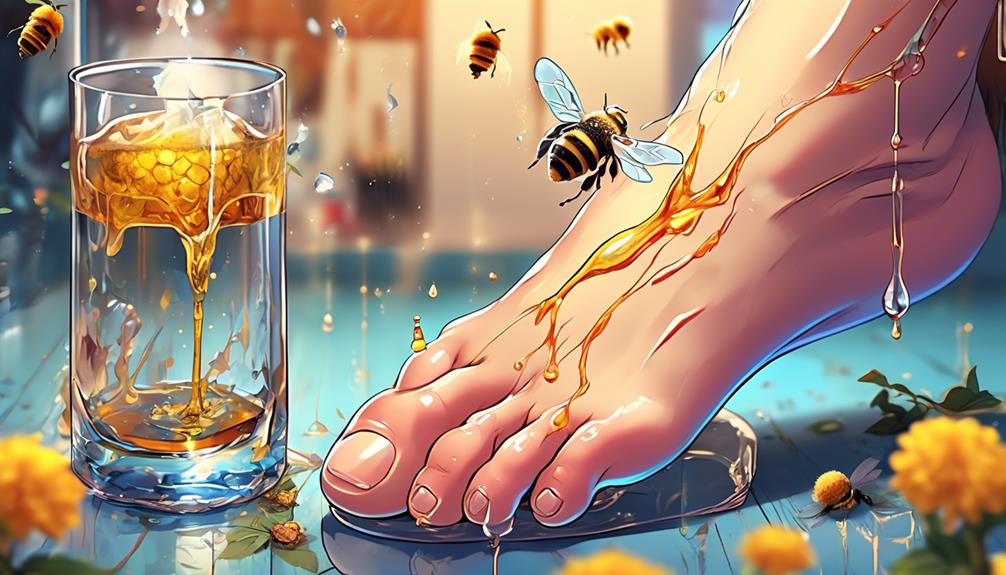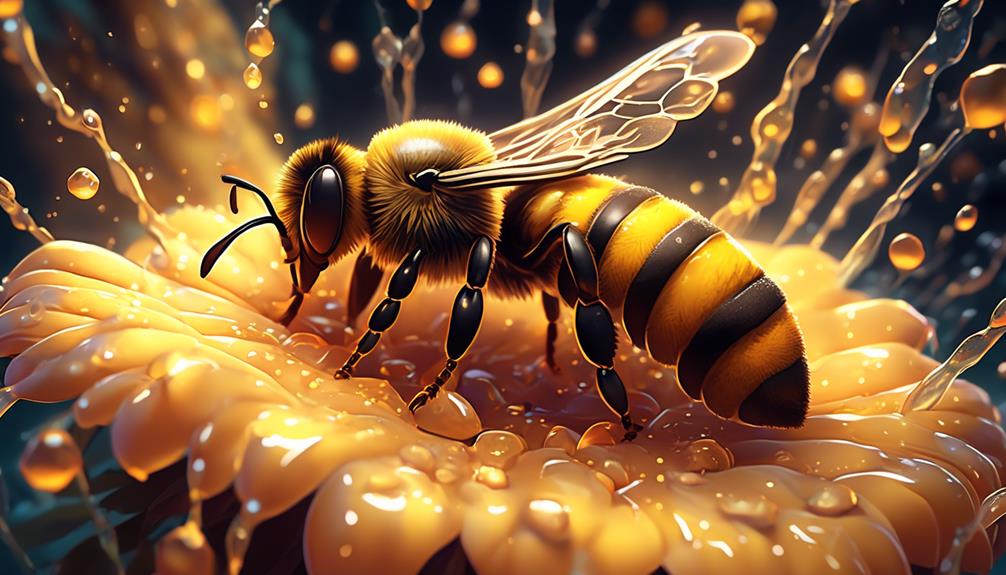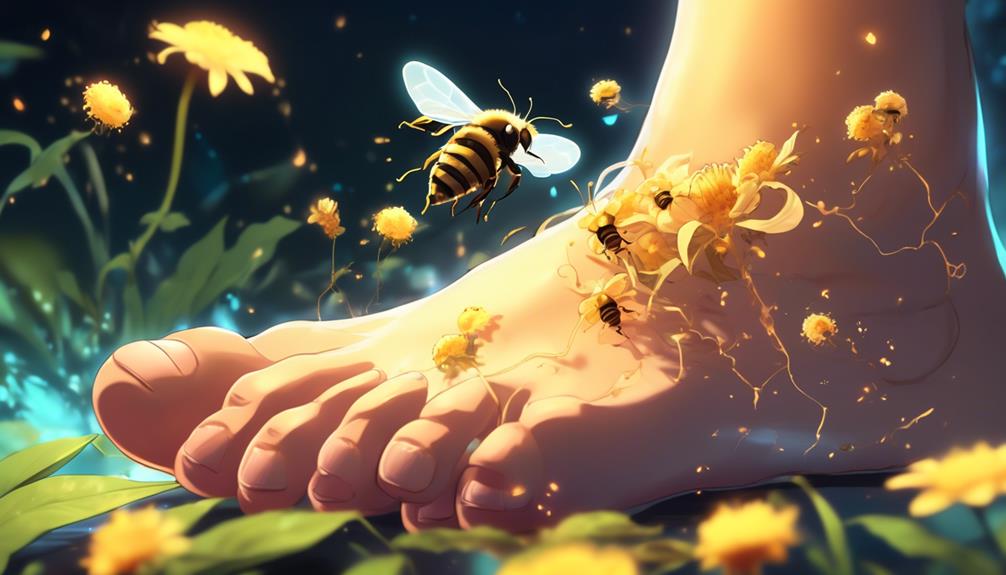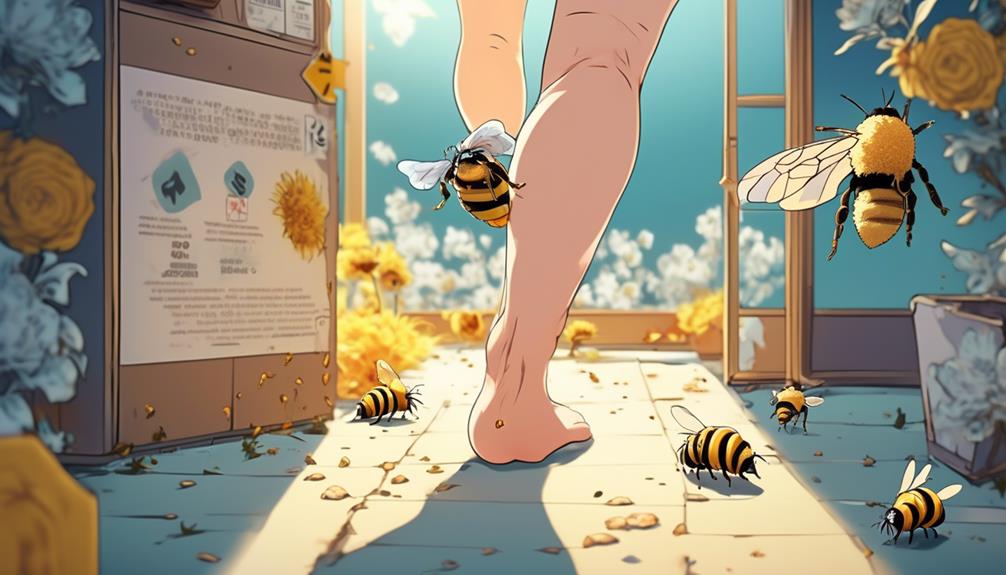Yearning for a unique bunion cure? Discover the surprising potential of bee venom's anti-inflammatory properties in treating this painful condition.

Can Bee Venom Cure Bunions?
You've probably heard the old saying, 'Every cloud has a silver lining', right? Well, it seems this could even apply to the painful nuisance of bunions.
Picture this: an unconventional cure in the form of bee venom. You might be thinking, 'Isn't that just adding insult to injury?' But recent research begs to differ.
Scientists are buzzing about the potential anti-inflammatory properties of bee venom, which could lead to a lesser-known treatment for bunions.
As bizarre as it sounds, you'll want to stick around to learn more about this sting in the tale.
Key Takeaways
- Bunions are bony protrusions that form on the joint at the base of the big toe, often caused by pressure and tight shoes.
- Bee venom contains compounds like melittin, adolapin, and apamin, which have anti-inflammatory and analgesic effects.
- Bee venom has the potential to reduce inflammation and offer relief for bunions characterized by painful inflammation.
- However, further research is needed, especially on humans, to confirm the effectiveness and safety of bee venom therapy for bunions.
Understanding Bunions: Causes and Symptoms

To understand bunions, it's essential to delve into their causes and symptoms. Bunions are bony protrusions that form on the joint at the base of your big toe. They're caused by pressure applied to your big toe over time, forcing it to lean against your second toe. This continual pressure can cause the structure of your foot to change, resulting in a bunion.
Your footwear plays a significant role in the development of bunions. Tight, narrow shoes, particularly high heels, can compress your toes, leading to bunions. But it's not just your shoes; certain inherited foot types and medical conditions such as arthritis can also contribute to bunion formation.
What about symptoms? Well, an obvious sign is the bulging bump on the outside of your base toe. You might also experience soreness, inflammation, and redness around your big toe joint. As the condition progresses, you could suffer from persistent or intermittent pain and even find it difficult to move your toe. In extreme cases, the skin over the bunion might become blistered or callused.
The Healing Properties of Bee Venom

You might find it surprising, but bee venom, a complex mixture of proteins, peptides, and enzymes, has potent healing properties that have been studied for various health applications, including the potential treatment of bunions.
Bee venom's healing potential lies in its unique combination of bioactive compounds. Melittin, the primary component, has anti-inflammatory and analgesic effects, which may help in reducing the pain and swelling caused by bunions. It also contains adolapin and apamin, both known for their powerful anti-inflammatory effects.
Here's a concise table summarizing the key components found in bee venom and their respective benefits:
Component | Percentage in Bee Venom | Known Benefits |
|---|---|---|
Melittin | 50% | Anti-inflammatory, Analgesic |
Adolapin | 2-5% | Anti-inflammatory |
Apamin | 2-3% | Anti-inflammatory |
Understanding these components and their respective effects aids in comprehending how bee venom may serve as a potential bunion treatment. However, it's crucial to remember that while promising, these findings are preliminary and more research is needed. As with any treatment, it's best to consult with a healthcare professional before incorporating bee venom into your healthcare routine.
Bee Venom and Inflammation Reduction

Building on the understanding of bee venom's components, let's explore how this potent mix can specifically target and reduce inflammation, a key factor in the development and persistence of bunions. Melittin, the primary active compound in bee venom, has been shown to possess potent anti-inflammatory and analgesic properties.
The mechanism of its action is remarkable. It inhibits the activation of inflammatory pathways, specifically the NF-kB pathway, which plays a critical role in producing inflammation-related proteins. By blocking this pathway, melittin prevents the release of these proteins, thereby reducing inflammation.
Moreover, melittin can stimulate the adrenal glands to produce cortisol, a natural anti-inflammatory hormone. This double-action approach is what makes bee venom a potential remedy for bunions, which are often characterized by painful inflammation.
However, it's important to note that bee venom therapy isn't a one-size-fits-all solution. You must consider potential allergic reactions and ensure it's administered under professional supervision. It's a serious treatment that requires a precise dose to balance efficacy and safety. So, while bee venom's potential in treating bunions is promising, it should be approached with caution.
Scientific Studies on Bee Venom and Bunions

Surprisingly few studies have directly investigated the impact of bee venom on bunions, though the existing research provides some intriguing insights into this potential treatment. You might wonder, "Can this substance really offer relief?" Well, let's delve into the science.
Bee venom contains various components, including melittin and apamin, that are believed to have anti-inflammatory and analgesic effects. These properties suggest that bee venom might be beneficial for conditions like bunions, which are characterized by inflammation and pain.
Here's a snapshot of the studies conducted:
Study | Findings | Relevance to Bunions |
|---|---|---|
Lee et al., 2015 | Bee venom reduced inflammation in mice. | Indicates potential for bunions. |
Choi et al., 2016 | Melittin suppressed inflammatory responses. | Suggests possible bunion relief. |
Park et al., 2017 | Apamin relieved pain in mice. | Points to potential bunion pain reduction. |
However, these studies were conducted on animals, not humans. Therefore, while they're promising, it's essential to approach the idea of bee venom as a bunion cure with caution until further research is done.
Risks and Considerations of Bee Venom Therapy

While the potential benefits of bee venom therapy for bunions are enticing, it's critical to consider the associated risks and precautions before embarking on this unconventional treatment path.
The primary risk is an allergic reaction, which can range from mild skin irritation to anaphylaxis, a life-threatening condition. If you've ever had an allergic reaction to a bee sting, this treatment isn't advisable.
Moreover, improper application of the venom can lead to skin damage, including blisters and ulcers. It's crucial to seek treatment from a trained professional to mitigate these risks.
Additionally, there's a lack of standardized dosing guidelines for bee venom therapy, which can lead to inconsistency in treatment outcomes.
Furthermore, while studies show promising results, they're mostly preliminary and lack robust clinical trials. Therefore, the effectiveness and safety of bee venom therapy for bunions remain unclear.
It's also worth noting that this therapy doesn't address the root cause of bunions, which is usually related to biomechanical imbalances or genetic factors.
Frequently Asked Questions
How Is Bee Venom Extracted for Therapeutic Use?
You're probably wondering how bee venom is extracted for therapeutic use. It's a fascinating process.
Beekeepers use a glass pane electrified with a mild voltage. Bees are drawn to the pane, and when they sting it, they're not harmed but their venom is collected.
This venom is then dried and purified. It's a high-tech process ensuring that the venom is clean and safe for medical use.
It's incredibly important in treatments for various health conditions.
Are There Any Alternative Treatments for Bunions Other Than Bee Venom?
Yes, there are several alternative treatments for bunions.
You can try non-surgical methods like wearing comfortable shoes, using bunion pads, or taking pain relievers.
Physiotherapy exercises can also help strengthen the foot and improve flexibility.
If your bunions are severe or persist, surgery might be a viable option.
Always consult with a healthcare professional to determine the best course of action for your specific condition.
Can Bee Venom Be Used for Other Health Conditions as Well?
Yes, you can use bee venom for other health conditions. It's been researched for its potential benefits in treating arthritis, neuralgia, and even some skin conditions.
However, it's crucial you don't self-administer bee venom. It can cause serious allergic reactions or side effects if it's not administered correctly.
Always consult a healthcare professional before trying any alternative treatments.
How Long Does It Take for Bee Venom Therapy to Show Results on Bunions?
You're probably wondering how long it'll take for results from bee venom therapy on your bunions. Unfortunately, it's not a quick fix, and results vary widely among individuals. Typically, you may start noticing changes after several weeks of consistent treatment.
However, it's crucial to remember that this therapy isn't a guaranteed cure and may not work for everyone. Always consult with a healthcare professional before starting any new treatment.
Is Bee Venom Therapy Covered by Health Insurance?
Whether bee venom therapy is covered by your health insurance depends largely on your specific plan and provider. It's not typically included in standard policies, as it's often considered an alternative or experimental treatment.
You'll need to check with your insurance company directly to confirm coverage. Remember, it's essential to weigh the potential benefits against the potential risks before opting for any form of therapy.
Conclusion
You've learned that bunions are painful, often caused by pressure and misalignment.
Bee venom, with its healing properties, could offer relief due to its anti-inflammatory effects.
While some studies suggest potential benefits, it's important to remember that bee venom therapy carries risks.
Always consult a healthcare professional before starting any new treatment.
In the end, the potential of bee venom in treating bunions is intriguing but needs further exploration.



